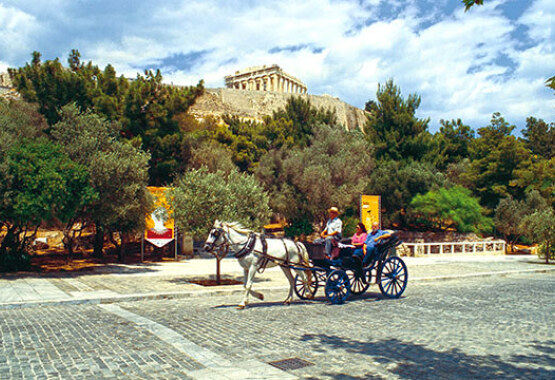Neighbourhoods in Athens
The “core” of the historic centre of Athens is the Plaka neighbourhood (at the eastern side of the Acropolis), which has been inhabited without interruption since antiquity. When you walk through the narrow labyrinthine streets lined with houses and mansions from the time of the Turkish occupation and the Neoclassical period (19th c.), you will have the impression of travelling with a “time machine”. You will encounter ancient monuments, such as the Lysikrates Monument, done by a wealthy donor of theatrical performances, the Roman Agora with the famed “Tower of the Winds” (1st c. B.C.) and Hadrian’s Library (132 A.D.), scores of bigger and smaller churches, true masterpieces of Byzantine art and architecture, as well as remnants of the Ottoman period (Fetihie Mosque, Tzistaraki Mosque, the Turkish Bath near the Tower of the Winds, the Muslim Seminary, et al.). There are also some interesting museums (Folk Art, Greek Children’s Art, Popular Musical Instruments, Frysira Art Gallery, etc.), lots of picturesque tavernas, cafés, bars, as well as shops selling souvenirs and traditional Greek products.
Continuing from Plaka you arrive at Monastiraki, a characteristic area of “old” Athens, with narrow streets and small buildings where the city’s traditional bazaar (Yousouroum) is held. Close to it is the Psyrri area, a traditional neighborhood which during the past few years has evolved into one of the most important “centres” of the town’s nightlife, with scores of bars, tavernas, ouzeris, clubs, etc.
However, the “heart” of the historical centre is the traditional commercial neighbourhood, with more than 2,500 shops of all kinds, which spreads out over the streets surrounding Ermou Street (the city’s best-known commercial street). The western “border” of the area is Athinas Street, where the foodstuff commerce is concentrated, reminding one strongly of the Middle East. Here are situated, among others, the neoclassical mansions of the Town Hall, the Municipal Market (where meat, fish and vegetables are sold) and spacious Kotzias Square.
Within the boundary of Athens’ historical centre also are the picturesque neighbourhoods of Makriyianni (close to the Acropolis, where the Acropolis Museum stands), Ano Petralona, Thiseion (where you will find small interesting museums and scores of cafés, bars and restaurants), Kerameikos and Metaxourgeio, as well as the Gazi area, with the former Gasworks, which now have been turned into a cultural centre of the Athens municipality (“Technopolis”).
Syntagma and Omonia are the main central squares of the town; they are linked by Stadiou Street and Panepistimiou Avenue, along which some of the town’s most beautiful Neoclassical buildings have been erected. Dominating Syntagma Square is the Greek Parliament building and in front of it the Monument of the Unknown Soldier, guarded by the Evzones in traditional costume. From this square starts the beautiful National Gardens (40 acres), south of which stands the impressive Zappeion Mansion (1874-1888). From there you can hed towards the Presidential Mansion (1897) and thence to the Panathenaikon (Kallimarmaro) Stadium, where the first Olympic Games in modern history were held (1896). From there, crossing the Mets neighbourhood, the road leads you to the First Cemetery, the oldest one in Athens, basically an outdoor sculpture display with a wealth of wonderful monumental tombstones by some of the most important sculptors of the 19th and 20th centuries.
From Omonia Square starts Patission street, a busy street with interesting buildings, amongst which are the Neoclassical mansions of the Polytechnic School and the National Archaeological Museum, which ranks among the leading museums in the world and hosts rare art treasures from the Neolithic era up to the Roman period. Close to the museum is the Exarcheia neighbourhood, a charming and very lively neighborhood, traditional a meeting point and home to many students and artists. From Exarcheia, crossing the Neapoli neighbourhood, you can climb the verdant Lycavittos Hill. From its top you have a view of the entire city, all the way to the sea.
On the other side of the hill is the Kolonaki neighborhood, whose boundary is Vassilissis Sophias Avenue, one of the most grandiose streets of Athens with beautiful buildings, many museums (Cycladic Art, Benaki, Byzantine and Christian Museum, War Museum, National Gallery) and green areas. In Kolonaki, which is considered to be the most “posh” area of the centre of Athens, you will find many shops selling high-end brands and high couture, modern restaurants, bars and cafés, while it is worthwhile to take a stroll through the central streets with their art déco, art nouveau and interbellum buildings.


